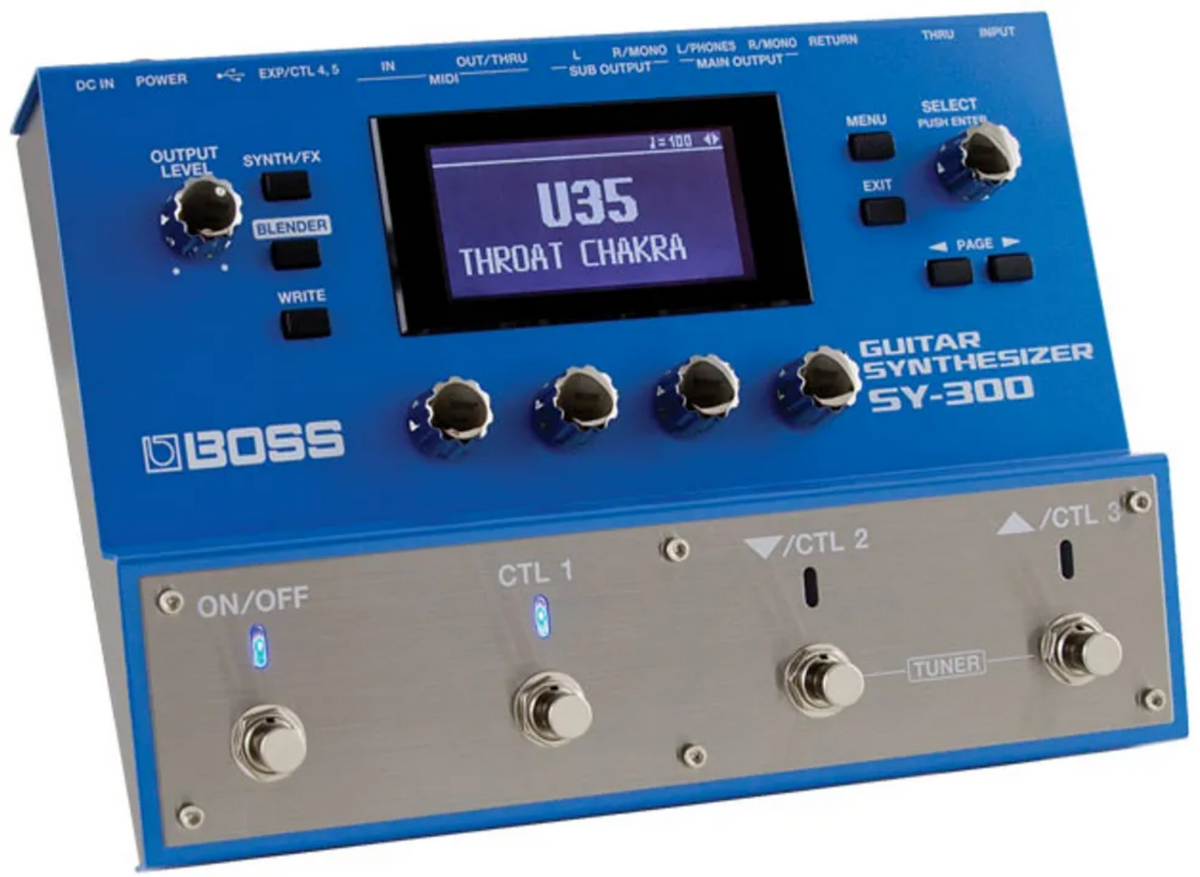
An impressively editable, intuitive, and organic-sounding digital synth that clears the path to creativity.
User friendly. Great tracking and sensitivity. Organic sounds for a digital guitar synth.
Expensive.
$699
Boss SY-300 Guitar Synthesizer
boss.info
Guitar synthesis has come a long way. Players are no longer doomed to invasive drilling for MIDI ports, special pickups, or fret wiring. These days one of the coolest guitar synth alternatives are stompboxes, and the new BOSS SY-300, a deep and capable digital guitar synth packed with LFOs, filters, effects, patches, and routing, is an intriguing and powerful option.
Synthesis Sans Ivories
Out of the box, the SY-300 is configured with 70 permanent presets and 99 slots for user patches. To create one, you simply press the synth button to edit a given patch using the LCD screen as your navigation window. While in edit mode, the four knobs beneath the screen are used to adjust parameters within your internal signal chain. Here you can stack LFOs, add effects such as chorus, flange and delay, and adjust their individual settings and where they appear in the signal chain. Effects may be applied globally, or to a specific LFO or effect. Should you want to use your own stomp boxes to effect the internal chain, there are Send/Return ports on the crown of the box. MIDI In and Out/Thru jacks are included, as well as a USB port. This allows you to use the Boss Tone Studio, a GUI for precise tweaking on your computer. The SY-300 can also hook up to the Boss Tone Central, a virtual library of downloadable presets. Altogether the SY-300 is an impressively flexible and editable package.
All In The Fingers
Many of the SY-300 presets are both intuitive and immediately usable. Some require a little more attention to detail—especially time-based effects. For example, P14 has a programmable 16-step sequencer built in and I had to sift through the Synth/FX edit mode to get the patch tempo up to speed. All of these controls take a little time to get used to. Thankfully, the controls are well laid out and the navigation is logical.
While digital guitar synthesis can be cold and sterile, the SY-300 is highly reactive to playing style and guitar choice.
While digital guitar synthesis can be cold and sterile, the SY-300 is highly reactive to playing style and guitar choice. Each pickup (or blend) retains its inherent characteristics. Tracking is also superb. Need proof? Try using a slide with the SY-300. Each note sings clear through the length of the string, without annoying glitchy, artifacts.
While a little background with synths and LFOs makes the SY-300 feel more familiar, Boss made this guitar synth very user friendly. And you can formulate odd combinations with ease. For instance, I was working with preset P03 "Fat Saw Brass", but wanted to try the 1st Oscillator from P12 "Lord Purple" in the second Oscillator position. By hitting the blender button and using the second knob beneath the LCD to cycle through the preset list, I located the "Lord Purple" oscillator. With the push of a button, my guitar tone was imbued with a pulse-width modulation that added a dirty, woozy warble that, yep—evoked Jon Lord's fat Deep Purple Hammond tones. The blender feature can also be used to produce new patches. Pushing down on the Select knob will randomly generate a signal chain every 5 seconds. If you find one you like, you press the Select Knob again (or turn CC to scroll back further in the randomizer) to stop. From there, you can tweak or write the new patch to a user slot. It's interactive, easy and a wonderful creative tool.
The Verdict
These voices and sounds are a mere fraction of what the SY-300 can do. And these relatively vast capabilities make the $699 street price—which is neither chump change nor an easy investment for a casual guitar synth enthusiast—a little easier to swallow. The SY-300 is delightfully intuitive and interactive. It tracks chords with ease, it doesn't glitch out when you play bends and harmonics, and, it actually reacts to the pressure of your playing. On top of giving you textures for otherworldly leads and fat rhythms, the SY-300 can also stand-in for a keyboardist. And while it's doesn't have the fat warmth, of an analog synth, it feels exceptionally organic for a digital synth. Best of all, the SY-300 makes it easy to create unusual and useful sounds, and that makes it a very powerful creative partner.


